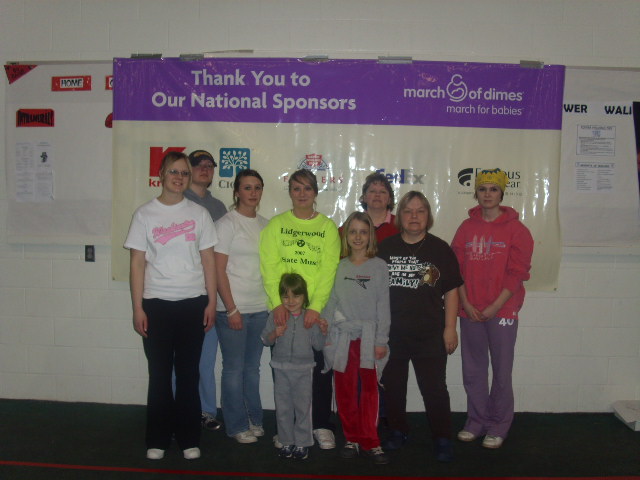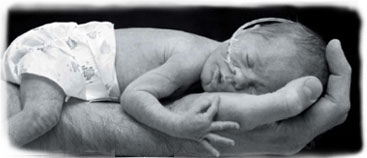This organization is dedicated to improving the health of babies by
preventing birth defects, premature birth and infant mortality. MOD is most
known for its successful vaccine against Polio which first struck the US in
1916. The disease killed thousands of children and paralyzing even more.
Former President Franklin D. Roosevelt was infected with Polio and thus the
March of Dimes was born.
MOD is conducting research to prevent prematurity, birth defects and infant
mortality just as it did to prevent Polio. With the help of volunteers and
community events such as the Walk for Babies, we aid in this much needed
research to give all babies a fighting chance.
The Walk for Babies, formerly March for Babies has been hosted by individual
MOD chapters for a while now. The closest ones in the past to Lidgerwood
include Fargo and Wahpeton events. 2009 will be the first year that
Lidgerwood will have its own Walk for Babies to support the MOD.
NeTia Richards and Dawn Haase are working with the March of Dimes Fargo
Chapter to host this event. They both have had cases that deal with the
issues that MOD is looking to prevent. NeTia's daughter Chloe was born
premature with pre-existing conditions including Gastroschisis, IUGR which
required immediate surgery and long NICU stays and later developed NEC.
Chloe is doing very well and is happy to share her story with others. Dawn's
nephew Tyler was born with a portion of his brain missing. He will have
certain life-long disabilities but for the most part functions just like a
normal child.
There are many more people in the community that we are sure has stories of
their own and we want to hear them. We are looking for a few, very
compelling stories of prematurity, birth defects and even infant mortality.
We are looking for a few ambassador families to speak at out event so if you
are interested in sharing your story contact us, email is preferred.
The 1st Annual Lidgerwood Walk for Babies will be held:
Saturday May 16th, 2009/Registration begins at 9 am and the walk starts at
10 am; awards and lunch to follow.
Located at Kugler Field (weather-permitting) otherwise the Lidgerwood
Activity Center.
How it works:
Individuals can walk or create/join a team to honor someone or to promote a
business, etc. Each walker/team pledges a goal amount and finds sponsors to
help them raise their goal amount. There are prizes for varying levels of
money that are made by each person.
The walk is advertised as a 3-mile walk but in reality you walk for only 1
hour. This hour represents the 54 babies that are born premature every hour.
28 of these babies will have lifelong health problems including Cerebral
Palsy, blindness, etc. and sadly 9 of these babies won't live to see their
first birthday. You can be a part of this by getting yourself, your friends,
family, employer or your business to form a team or sponsor someone else to
do this.
Not quite an hour of walking is worth many lifetimes for people all across
the country!
We are hoping to get the local area schools involved in the walk by offering
them to compete (Elementary vs. high School) for a pizza party as well.
If you are interested in becoming a team captain or just a walker, or just
want to donate to the cause refer to the contact information. We will help
all teams/walkers if need be to set up their free online fundraising web
pages.
www.marchofdimes.com (corporate site)
www.marchforbabies.org (walk registry)
www.marchforbabies.org/netiarichards (NeTia/Team Chloe site from last year)
Contact Info:
NeTia Richards
701-538-4678
netia@dakotamicro.com
netiajrichards@hotmail.com
Dawn Haase
701-640-6220
dawn@dakotamicro.com






Infant Mortality Overview
Infant mortality is defined as death occurring during the first year of life
and is an important summary reflecting social, political, health care
delivery and medical outcomes in a geographic area. Infant deaths can be
further classified into neonatal (0-27 days) and postneonatal (28-365 days)
periods. Neonatal mortality is typically associated with events surrounding
the prenatal period and the delivery, whereas postneonatal deaths are more
likely to be associated with conditions or events that arise after the
delivery and may reflect environmental factors. PeriStats also provides data
on the causes of infant deaths.
. In North Dakota in 2004, 48 infants died before reaching their first
birthday, an infant mortality rate of 5.9 per 1,000 live births.
. Between 1994 and 2004, the infant mortality rate in North Dakota declined
18%.
. In 2004, 77.1% of infant deaths occurred in the neonatal period, and
22.9% occurred in the postneonatal period.
. Some of the leading causes of infant death in the United States include
the following: birth defects; prematurity/low birthweight; sudden infant
death syndrome; maternal complications of pregnancy and respiratory distress
syndrome.
Perinatal Overview
PeriStats compiles maternal and infant health data from multiple sources.
These data are often referred to as perinatal data. The term "perinatal" can
be used in a generic or a very specific way. It means around (peri-) the
time of birth (-natal), so it can be used to refer to the entire or parts of
the period around conception and through the first year of life.
In an average week in the United States:
. 79,584 babies are born.
. 10,056 babies are born preterm.
. 6,511 babies are born low birthweight.
. 536 babies die before reaching their first birthday.
. In the United States in 2005, 96.6% of all live births were singleton
births and 3.4% were multiple births.
. Every 4 1/2 minutes a baby is born with a birth defect in the United
States.
. In 2004, birth defects accounted for about 1 in 5 infant deaths in the
United States.
. In the United States in 2005, 30.3% of live births were cesarean
deliveries and 69.7% were vaginal deliveries.
. In 2002, about 1 in 28 infants (3.6% of live births) was born to a woman
receiving late or no prenatal care in the United States.
. In 2005, the annual societal economic cost (medical, educational, and
lost productivity) associated with preterm birth in the United States was at
least $26.2 billion.
. Screening for the 29 core newborn screening conditions is universally
required by rule or law and fully implemented in Alaska, Arkansas, Colorado,
Delaware, the District of Columbia, Florida, Hawaii, Illinois, Indiana,
Iowa, Kansas, Louisiana, Maryland, Minnesota, Mississippi, Missouri,
Montana, New Mexico, New York, Rhode Island, Vermont, Virginia, and Wyoming.

